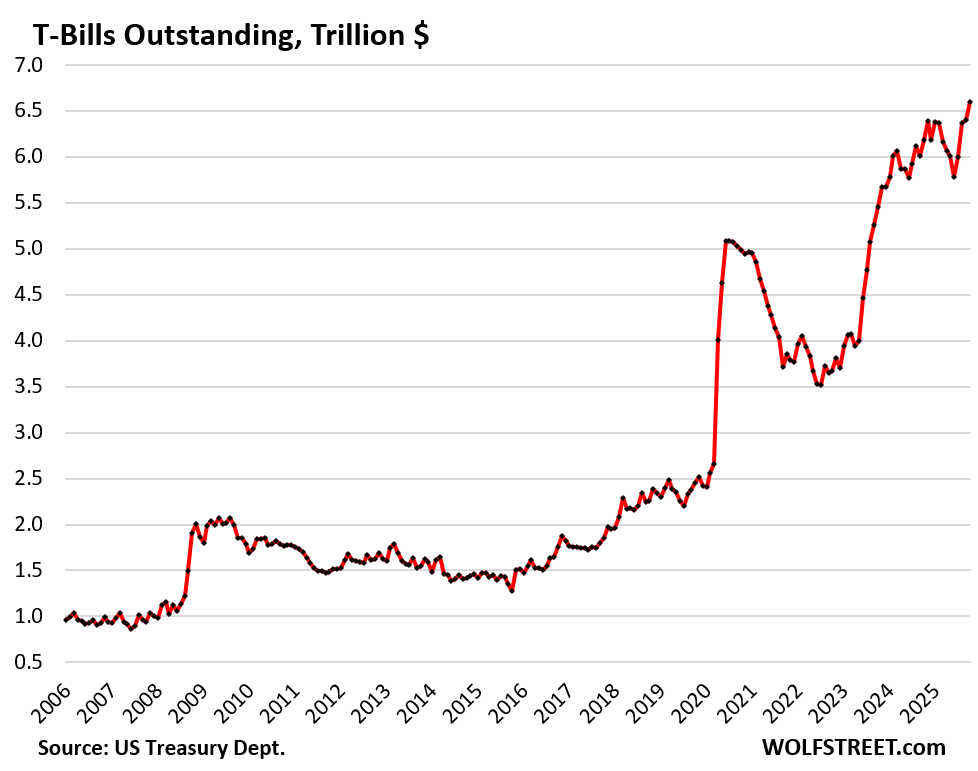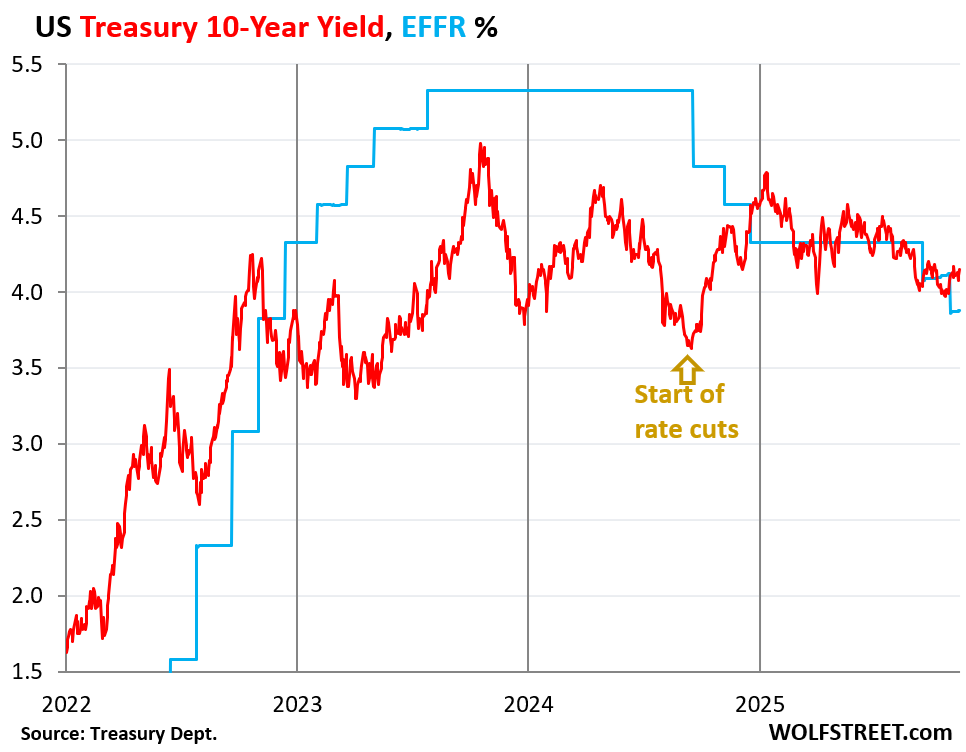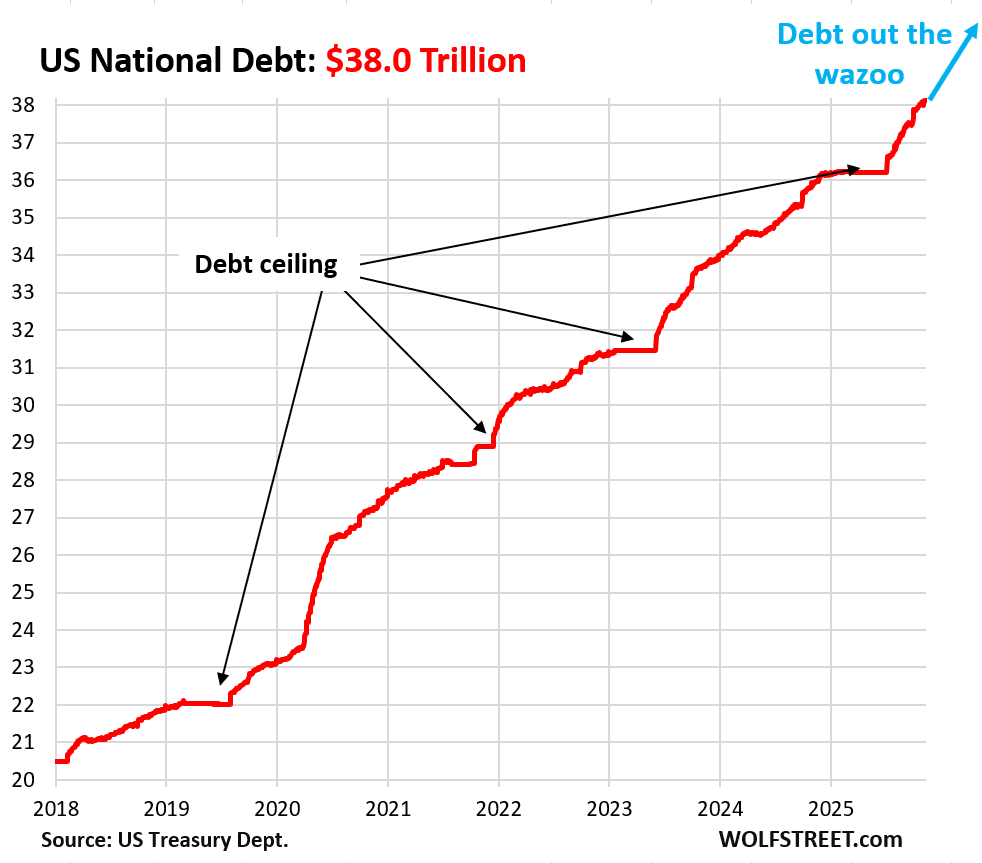Long-term Treasury yields under pressure, amid large auctions of notes and bonds, despite shift to T-bills.
By Wolf Richter for WOLF STREET.
This week, despite being shortened by Veterans Day when the bond market is closed, the government sold $694 billion in Treasury securities spread over 9 auctions on three days.
Of these auction sales, $549 billion were Treasury bills with maturities from 4 weeks to 52 weeks, including $110 billion of 4-week bills, and $101 billion in 6-week bills.
| Type | Auction date | Billion $ |
| Bills 6-week | Nov-10 | 101.1 |
| Bills 13-week | Nov-10 | 91.5 |
| Bills 17-week | Nov-12 | 69.2 |
| Bills 26-week | Nov-10 | 81.8 |
| Bills 4-week | Nov-13 | 110.3 |
| Bills 8-week | Nov-13 | 95.3 |
| Bills | 549.1 |
And $144 billion of the auction sales this week were notes and bonds, including $48 billion of 10-year notes and $29 billion of 30-year bonds.
| Notes & Bonds | Auction date | Billion $ |
| Notes 3-year | Nov-12 | 67.0 |
| Notes 10-year | Nov-12 | 48.5 |
| Bonds 30-year | Nov-13 | 28.9 |
| Notes & bonds | 144.4 | |
| Total auction sales | 693.5 | |
The note and bond auction sales replaced some maturing notes and bonds, and added a lot of new debt, and this is where the debt grows in leaps and bounds. For example:
The $48.5 billion of 10-year Treasury notes sold at auction this week at a yield of 4.07% replace $24.1 billion of 10-year notes that were issued in November 2015 at a yield of 2.30% and mature now: The issue amount doubled, and the yield is 1.77 percentage points higher, on double the principal!
T-bills mature constantly in huge volume and have to be replaced with new sales just to stay level. The $101 billion of 6-week T-bills sold on November 10 will mature on December 26 and will be replaced via new auction sales, plus whatever amounts will be added to the auction to fund the ongoing deficits.
The $82 billion of 26-week T-bills sold this week will mature on May 14, 2026, and will have to be refinanced then via a new issue, plus whatever new funds will be needed to fund the additional deficits.
As the T-bill pile grows, the auctions get larger and larger as maturing T-bills will have to be refinanced, on top of the issuance needed to fund the ongoing deficits with new T-bills. So the already huge T-bill auctions will become gigantic.
But so far, so good. These T-bill auctions are well-oiled machines. Investors, including big companies, often use T-bills on automatic rollover to manage their cash, like they would use money market funds.
The Fed is also preparing to replace maturing MBS with T-bills after QT ends in December. MBS will continue to come off the balance sheet after QT ends until they’re gone. At the current rates at which MBS come off the balance sheet, the Fed would buy $15-19 billion in T-bills a month. The market has to continue to absorb that amount of MBS. The Fed has already shed $670 billion of MBS since QT started, but still holds $2.1 trillion that it will replace with $2.1 trillion in T-bills as these MBS come off over the next few years. And investors are going to have to absorb an extra $2.1 trillion in MBS.
T-bills outstanding ballooned to a record $6.59 trillion by the end of October, but notes and bonds outstanding ballooned too, and so the share of T-bills of the overall marketable debt isn’t setting records:

T-bills’ share of the $30.0 trillion in marketable Treasury securities (= total debt minus securities “held internally,” such as by government pension funds) at the end of October rose to 22.0%, which is high, but well below the two recent crisis dates.
During crisis events, the government issued huge amounts of T-bills quickly to fund its sudden stimulus and bailout expenditures, which for short periods causes T-bills’ share of the total to spike, such as to a 34.4% share in November 2008 during the Financial Crisis, or to a 25.5% share in June 2020. During those times, the Fed became a huge buyer as part of its QE program.

Long-term yields are under pressure. The 10-year Treasury yield rose today by 4 basis points to 4.15% currently, over the past four days to 4.29% today.
The 10-year Treasury yield (red) is now 27 basis points above the EFFR (blue). In normal credit markets, long-term yields, such as the 10-year Treasury yield, are quite a bit higher than short-term yields, such as the EFFR:

The ballooning federal debt hit $38.16 trillion as of November 13. The portion of the issuance that replaces maturing debt does not add to the US government debt. But the additional issuance to fund the new deficits adds to the amount of the debt.

Enjoy reading WOLF STREET and want to support it? You can donate. I appreciate it immensely. Click on the mug to find out how:
![]()


$38 Trillion, if you print it all in 1 dollar bill, is there enough to cover the entire landmass of United States? We throw around T like it’s nothing but…
Btw, things are going in wrong direction, but good to see at least 10 yrs is heading higher if it means giving fixed income investor a fighting chance at TINA and also keep mortage rates higher so RE agents can STFU about 30yrs rates dropping soon…
“Long-term yields are under pressure. The 10-year Treasury yield rose today by 4 basis points to 4.15% currently, over the past four days to 4.29% today.”
I wonder how much debt must the U.S. have for buyers of U.S. Treasuries to start worrying that the U.S. gov’t won’t pay back their Treasuries, or worry that the Fed will be printing so much money that the inflation rate will be higher than the interest rate on the Treasuries.
Let’s see… A dollar is ~16 square inches. That’s 9 dollars per square foot, which makes for 4.22 trillion square feet, or 150K square miles. But the US is 3M square miles, so we’re not even 10% of the way there. We have a lot more debt to go!
Surely the debt situation is unsustainable? Grow economy through increased productivity, cut spending, default or default through high inflation.
Wolf, what is your prediction?
I wonder when do buyers of U.S. Treasuries start to worry that the U.S. gov’t won’t pay back their Treasuries, or worry that the Fed will be printing so much money that the inflation rate will be higher than the interest rate on the Treasuries. How much debt does that have to be ?